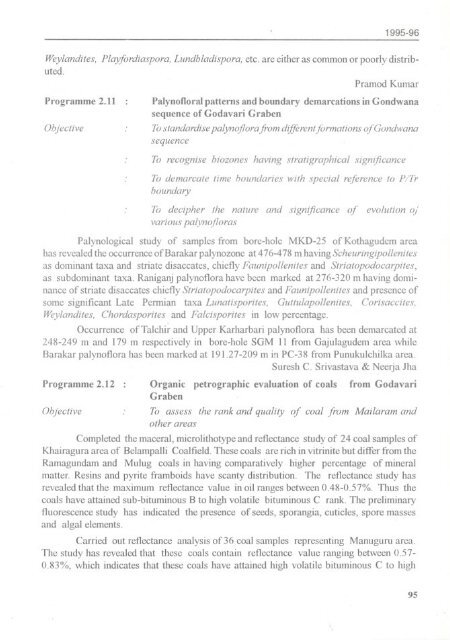1995-96 - Birbal Sahni Institute of Palaeobotany
1995-96 - Birbal Sahni Institute of Palaeobotany
1995-96 - Birbal Sahni Institute of Palaeobotany
You also want an ePaper? Increase the reach of your titles
YUMPU automatically turns print PDFs into web optimized ePapers that Google loves.
<strong>1995</strong>-<strong>96</strong><br />
Weylandites, Playfordiaspora, Lundbladispora, etc. are eithcr as common or poorly distributed.<br />
Pramod Kumar<br />
Programme<br />
Objective<br />
2.tI<br />
PalynoOora! patterns and boundary demarcations in Gondwana<br />
sequence <strong>of</strong> Godavari Graben<br />
To standardise palynojlorafrom<br />
sequence<br />
dijJerentj(Jrmations <strong>of</strong> Gondwana<br />
To recognise biozones having stratigraphical significance<br />
To demarcate time boundaries wuh special reference to P'Tr<br />
boundary<br />
To decipher the nature and significance <strong>of</strong> evolution 0/<br />
various palynojloras<br />
Palynological study <strong>of</strong> samples from bore-hole MKD-25 <strong>of</strong> Kothagudem area<br />
has revealed the occurrence <strong>of</strong> Barakar palynozone at 476-478 m having Scheurmglpollenites<br />
as dominant taxa and striate disaccates, chiefly Faunipollenites and Striatopodocarpites,<br />
as subdominant taxa. Raniganj palyn<strong>of</strong>lora have been marked at 276-320 m having dominance<br />
<strong>of</strong> striate disaecates chiefly Striatopodocarpites and Faunipollenites and presence <strong>of</strong><br />
some significant Late Permian taxa Lunatisporites, GUffulapollenites, Corisaccites,<br />
Weylandites, Chordasporites and Falcisporites in low percentage.<br />
Occurrence <strong>of</strong> Talch.ir and Upper Karharbari palyn<strong>of</strong>lora has been demarcated at<br />
248-249 m and 179 m respectively in bore-hole SGM II from Gajulagudem area while<br />
Barakar palyn<strong>of</strong>lora has been marked at 19j .27-209 m i.tl PC-38 from Punukulchilka area.<br />
Suresh C. Srivastava & Neerja Jha<br />
Programme 2.12<br />
Objective<br />
Organic petrographic evaluation <strong>of</strong> coals from Godavari<br />
Graben<br />
To assess the rank and quality <strong>of</strong> coal from Mailaram and<br />
other areas<br />
Completed the maceral, microlithotype and reflectance study <strong>of</strong> 24 coal samples <strong>of</strong><br />
Khairagura area <strong>of</strong> Belampalli Coalfield. These coals are rich i.ovitrinite but differ from the<br />
Ramagundam and Mulug coals in having comparatively higher percentage <strong>of</strong> mineral<br />
matter. Resins and pyrite framboids have scanty distribution. The reflectance study has<br />
revealed that the max.imum reflectance value i.ooil ranges between 0.48-0.57%. Thus the<br />
coals have atta.ined sub-bituminous B to high volatile bituminous C rank. The preliminary<br />
fluorescence study has indicated the presence <strong>of</strong> seeds, sporangia, cuticles, spore masses<br />
and algal elements.<br />
Carried out reflectance analysis <strong>of</strong>36 coal samples representing Manuguru area.<br />
The study has revealed that these coals contain reflectance value ranging between 0.57<br />
0.83%. which i.odicates that these coals have attained high volatile bituminous C to high<br />
95

















